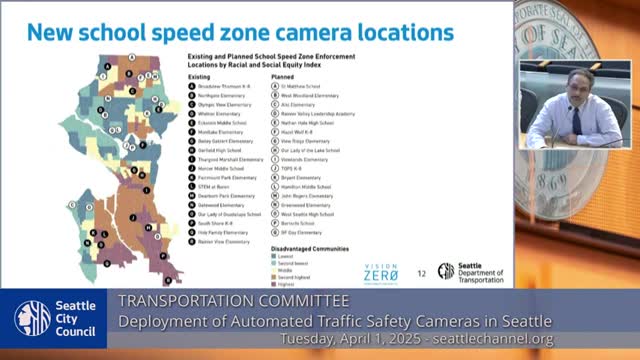City departments collaborate on expansion of automated traffic safety camera program
April 06, 2025 | Seattle, King County, Washington
Thanks to Scribe from Workplace AI , all articles about Washington are free for you to enjoy throughout 2025!

This article was created by AI using a video recording of the meeting. It summarizes the key points discussed, but for full details and context, please refer to the video of the full meeting. Link to Full Meeting
The program is a collaborative effort involving three city departments: the Seattle Department of Transportation (SDOT), the Seattle Police Department (SPD), and the Municipal Court. Each department has distinct responsibilities, ensuring a comprehensive approach to traffic safety. SDOT focuses on engineering aspects, including identifying camera locations and overseeing the design and construction processes. Meanwhile, SPD manages the vendor contracts for the cameras, which are not owned by the city but provided by a third-party vendor. This arrangement incurs no upfront costs for the city, although ongoing monthly fees of around $4,000 per camera are charged.
The Municipal Court plays a crucial role in managing court proceedings related to traffic violations captured by these cameras. They handle payment collections and offer fine mitigation options for individuals receiving public assistance, such as ticket debt reduction and payment plans.
Recent changes in state legislation have further streamlined the program. New laws now allow civilian employees within SPD and SDOT to review citations, expanding the pool of reviewers and facilitating a more efficient process for managing safety camera infractions. Additionally, the legislation mandates safety and equity analyses for the installation and relocation of cameras, ensuring that these measures are implemented fairly across the community.
As Seattle moves forward with these enhancements, the city aims to improve road safety and reduce traffic violations, ultimately benefiting residents and visitors alike. The collaborative efforts of the involved departments and the recent legislative changes are expected to create a more effective and equitable traffic safety program in the city.
Converted from Transportation Committee 4/1/2025 meeting on April 06, 2025
Link to Full Meeting
Comments
View full meeting
This article is based on a recent meeting—watch the full video and explore the complete transcript for deeper insights into the discussion.
View full meeting